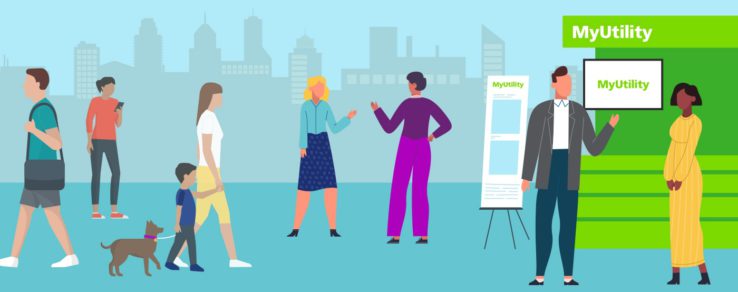Your role as a utility provider goes beyond pipes, wires, meters or bills — it’s about showing up for your community in ways that build trust. In today’s “phygital” (physical plus digital) world, this means meeting customers where they are, both online and in person.
Of course, limited budgets, time and staffing can make these efforts feel challenging. But with thoughtful strategies for utility community engagement, you can bridge the gap, strengthen relationships and show your customers that you’re invested in their lives — every step of the way.
Here’s how you can harness the power of utility community engagement to foster connection, increase satisfaction and make a lasting impact where you serve.
Use Social Media to Your Advantage
Social media is one of the most powerful tools for connecting with your community; it’s accessible, cost-effective and allows for real-time interaction. But simply being online isn’t enough. You need an approach that engages your audience consistently and meaningfully.
- Be consistent: A regular posting schedule keeps your utility top of mind. Whether it’s weekly water conservation tips or updates about local events, consistency is key.
- Boost interaction: Interactive content — polls, quizzes, games or infographics — can draw up to five times more views than static posts.
- Highlight your community: Encourage user-generated content (UGC) from residents to share their experiences and feature them on your platforms.
- Work collaboratively: Partner alongside community influencers to amplify your messaging and engage with local groups and organizations for cross-promotion.
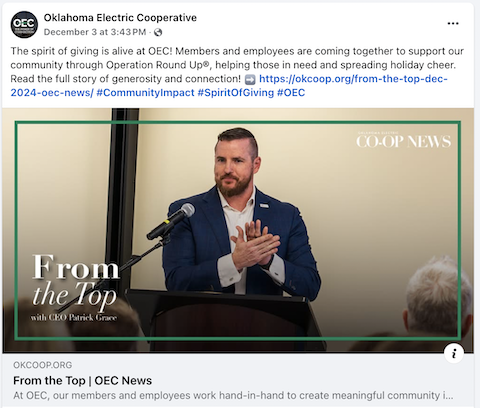
For example, Oklahoma Electric Cooperative (OEC) shared a Facebook post spotlighting Operation Round Up®, a program allowing members to round up their monthly electric bills to support neighbors in need. While each member’s contribution may only be a few extra cents — averaging around $6 annually — this collective effort has provided significant relief to families across OEC’s seven-county service area. By highlighting the program’s impact, OEC inspires others to participate and fosters a stronger bond among its members.
Organize Low-Cost Community Events
There’s no substitute for face-to-face interaction when it comes to building trust with your customers. Community events — whether workshops, town halls or local fairs — are an opportunity to connect directly, answer questions and show that you’re listening. These moments don’t have to be extravagant or expensive; the true value comes from showing up, being present and demonstrating your commitment to serving the people you support.
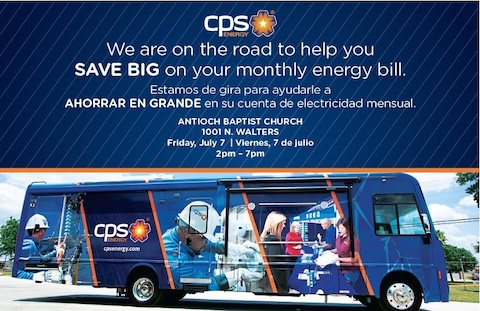
Take CPS Energy as an example. It created mobile support buses that traveled into neighborhoods to ensure meaningful utility community connections. Representatives were on hand to answer questions, provide assistance and gather feedback, showing their dedication to both communication and transparency. But they didn’t stop there.
Digitally, CPS Energy complemented this “boots on the ground” initiative by partnering with Questline Digital to create a targeted email campaign. The personal value email campaign was designed to educate customers on energy use, savings opportunities and upcoming rate increases. Personalized fields in the emails displayed each customer’s monthly energy usage, explained the reasons for the rate changes and broke down how these adjustments would affect their bills.
The campaign wasn’t just informative, it was highly effective, achieving a 37% open rate and 2.5% click-through rate — more than double the industry benchmark for promotional messages. More importantly, it showed utility community members that CPS Energy was there to help, offering clear and accessible information, and not trying to hide anything about rate increases. By blending in-person initiatives and digital outreach, CPS Energy demonstrated how thoughtful engagement can strengthen relationships and leave customers feeling supported and informed.
Collaborate with Community Partners
Collaboration is a powerful way to expand your reach and resources. By partnering with schools, nonprofits and local businesses, you can deliver meaningful events and programs that benefit your utility community while maximizing efficiency.
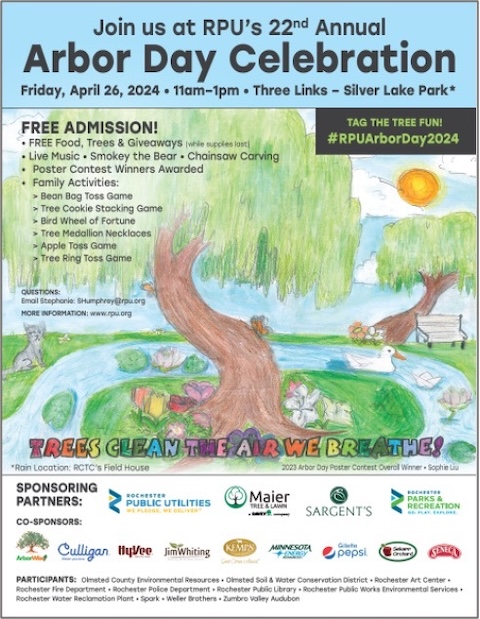
Rochester Public Utilities (RPU) in Minnesota demonstrates the value of strategic partnerships. For 20 years, they’ve co-hosted the city’s annual Arbor Day Celebration with local organizations to educate customers about conservation and energy efficiency. They also team up with Minnesota Energy Resources for weatherization events, providing LED lightbulbs and energy-saving tips, and offer free “Saving Energy 101” workshops and energy audits to low-income customers.
Partnerships with private sector entities can also bring specialized tools and expertise, allowing you to deliver even more impactful programs. Additionally, researching grants and funding opportunities can provide extra support to grow these initiatives without straining your resources.
Implement Educational Content and Email Marketing
Your customers rely on you for guidance and clear information, especially when it comes to managing utility costs and understanding energy or water usage. Sharing helpful, relevant content — like articles, FAQs, webinars or newsletters — positions you as a reliable subject matter expert while strengthening your connection with the community.
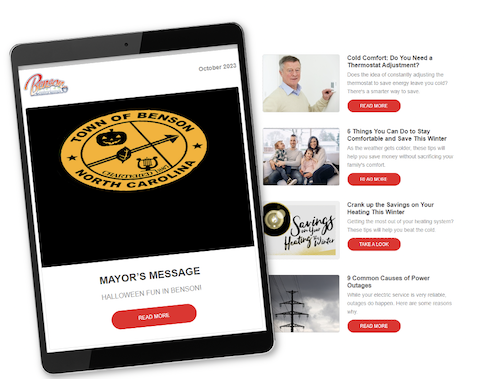
For example, Benson, North Carolina, transitioned from a printed newsletter to a digital eNewsletter to better engage its utility community. By incorporating articles, videos and infographics from Questline Digital’s Content Catalog, Benson’s municipal utility turned its communications into a valuable resource rich with useful energy news and efficiency tips. The effort not only boosted engagement — with an impressive 52.4% open rate — but also gave insights into what customers care about most, helping them tailor future content to better meet community needs.
To achieve similar success, consider hosting webinars or virtual workshops on relevant topics and then repurposing that material across platforms to maximize its impact. Collect email sign-ups through your website, social media or events, and offer incentives like exclusive updates or newsletters to encourage participation. With the help of email automation tools, you can efficiently schedule and manage campaigns to ensure consistent communication without overburdening your team.
Focus on High-Impact Activities and Make Data-Driven Decisions
Not all utility community engagement efforts are created equal. With limited resources, utilities must be strategic about where they invest their time and energy. The goal isn’t to do everything but to do the right things that genuinely matter to your community.
Start by aligning your initiatives with your core strategic goals. What are the most pressing needs in your service area? Prioritize these focus areas and go deep rather than spreading yourself thin. Then, delegation becomes your secret weapon. Leverage volunteers, partner with interns or bring in specialized agencies to handle complex projects. This approach frees up your team to focus on broader objectives.
Most importantly, set key performance indicators (KPIs) for your engagement efforts, such as:
- Participation rate: How many utility community members join engagement activities, like events, surveys or workshops?
- Reach and impressions: How many interactions are your social posts getting? Is it with the right people?
- Click-through rate and enrollment rates: Are customers clicking through emails to sign up for your programs and services?
- Customer satisfaction scores (CSAT): How are your community members ranking their level of satisfaction with your utility?
When collecting data, be transparent about how it’s used to refine your services and address community needs. Sharing your findings and demonstrating how feedback has influenced your initiatives can build trust and encourage further engagement. Small-scale pilot programs are another effective way to innovate without overcommitting resources. Test new ideas, measure their impact and adapt based on the results.
Embrace Utility Community Engagement as a Journey
Utility community engagement is not a one-time effort but an ongoing journey. By fostering genuine connections, addressing pressing needs and continuously adapting your strategy, you can demonstrate your commitment to the people you serve.
Whether through regular social media updates, face-to-face events or tailored digital content, every effort shows your customers that they are at the core of your mission. Embrace a holistic and adaptive approach to engagement, recognizing that each interaction is an opportunity to make a difference.

